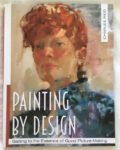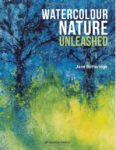This 144-page paperback is one of those books that's difficult to categorise. The title and…

Pulling Your Paintings Together, Charles Reid – Book Review
You have to be patient waiting for the prices of these Charles Reid books to drop to something at the high end of acceptability but this one appeared briefly in the window, so I had to go for it. It’s a 160-page paperback.
I know I must say this about every book that I read but this is a strange book. It’s a book of two halves – one 40 pages long and one 120 pages long. It doesn’t sound like an even split, but I learned as much from that first 40 pages as from the whole of the rest of the book.
That first 40 pages are about drawing, contour drawing in particular. From what I can tell, all four of Charles’ most famous books start off in this way. I’ve only read two of those books, but the description on contour drawing in this book is better than that in Painting By Design. My contour drawing took a big step forward after reading this book. I think it’s the way he emphasises things like keeping the pen in the paper, starting with the eyes and face, leaving some edges missing and wandering off into internal and background shapes that does it. And about how he points out that this brings everything together. And how he illustrates this with examples.
And then there’s the other 120 pages. It’s divided up into chapters but feels like a random ramble among the paintings of Charles and his students with no overriding storyline connecting it all together. I had no sense of where we were going. When I look at the notes I’ve made on this book (I do stuff like that – it helps all the information sink in) they just look like a long list of tips. It looks like I’ve started new paragraphs in random places whereas, in reality, I started a new paragraph whenever I got to a new chapter. That’s not to say these 120 pages weren’t useful – there was lots of useful stuff in there but it just wasn’t organised properly. I also found Charles contradicted himself in places, telling us not to do something in one place, then doing it himself in another. And there were far too many places where Charles would show us a painting and ask questions about it without giving us answers ”Can you see where I emphasised local colour? Why did I do this?” Well I think I see where you’re talking about, but it would be quite useful” if you could tell me why rather than just asking a question.
As is usual in these reviews, a word about the artwork and whether there’s any inspiration there in just looking at the pictures. Well, yes, there’s some great artwork in there but (unlike in Painting By Design) there are also some that Charles sounds proud of but look like absolute clunkers to me. Paintings where the background has similar value and colours to the subject, making them look indistinguishable. It’s one thing to have something like this on a little bit of the subject boundary, so that there’s a background shape and a subject shape that combine into an interesting compound shape. But when the background abuts almost all the subject’s outline, that looks amateurish.
This book’s an interesting barometer of how far I’ve come as an artist. There are a couple of demonstrations in there that I just roll my eyes at – a demonstration has to be really special these days to be interesting to me. As I say above, there were paintings by the author in this one that I didn’t like and knew why I didn’t like them. There are ideas in this book that I don’t 100% buy into but might try out (eg moving away from my three key primaries approach to letting more than one of each primary have a starting role). But, on the other hand, I’m not so knowledgeable and experienced that I can confidently answer all the questions Charles asks the reader.
So, the rating. This wasn’t amazing but it was worth reading and I’d buy it again if I was Bill Murray in Groundhog Day. It’s the first 40 pages that are the highlight. I’m going to give this a solid three palettes.
🎨🎨🎨
You can find this book and more reviews of it at Amazon UK here.As an Amazon Associate, I earn commission from qualifying purchases but this costs absolutely nothing extra to you.








Leave a Reply